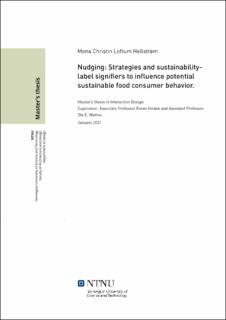Nudging: Strategies and sustainability-label signifiers to influence potential sustainable food consumer behavior.
Master thesis
Permanent lenke
https://hdl.handle.net/11250/2776825Utgivelsesdato
2021Metadata
Vis full innførselSamlinger
- Institutt for design [1129]
Sammendrag
Matproduksjon og forbruk er en av de viktigste drivkreftene og bidragsyterne tilmiljøskader i dag. For å beskytte naturens ressurser og behovene til fremtidigegenerasjoner, bør våre spisevaner, valg av mat og kjøpsbeslutninger snarlig tilpassestil et bærekraftig kosthold. Det viktige ansvaret forbrukerne har for å oppnå dette erubestridelig, men hver dag står de overfor mange komplekse valg, som kanskje må løsesraskt i en travel hverdag. Noen beslutninger de tar er gode, noen tilfeldige og noendårlige med tanke på deres egen helse og trivsel for miljøet og samfunnet. De er ogsåbasert på individuelle motivasjoner. Forbrukernes atferd er ikke den samme ogmotivasjonen for kjøpsbeslutninger utløses av mange forskjellige faktorer. Alle i verdenbruker den innsikten de har for å ta valg og beslutninger. Muligheter for å hjelpeforbrukeren med å ta bedre beslutninger for seg selv, samfunnet og miljøet ligger ikunnskap om denne innsikten.
Eksisterende teori og arbeid som omhandler segmentering av forbrukere og de mangemotivasjonsfaktorene for kjøpsatferd for mat, beslutningstaking og drivere for potensieltbærekraftig forbruk hos forskjellige forbrukere, er studert i denne masteroppgaven.I tillegg tar den for seg hvordan nudge-design kan brukes til å motivere og inspirere tilmer bærekraftig kjøpsatferd av mat i digitale dagligvarebutikker. Innsikt og data fradenne forskningen har blitt analysert, hentet ut og brukt til å svare på mineforskningsspørsmål og for å utvikle en segmenteringsmodell, forbrukersegmentprofiler,nudge-strategier og designforslag.
En foreslått segmenteringsmodell for potensiell bærekraftig atferd i dennemasteroppgaven er basert på fem grunnleggende drivere for atferd: Sosialdemografi,psykografi, forbrukernes bærekraftsbevissthet, matrelatert livsstil og heuristikk. Trepotensielle bærekraftige forbrukersegmenter utmerker seg: “Utforsker”, “Sannsynligforbruker” og “Tilfeldig kjøper”. Segmenteringsmodellen blir deretter brukt til å utviklenudge-strategier og bærekraftsdesign og belyser hvordan disse kan være effektive åbruke for å motivere forbrukere i de forskjellige segmentene. Strategiene er konstruertav tre komponenter: 1) Motivasjonsnivået for kjøpsatferd basert på verdier, holdningerog matrelatert livsstil, 2) Hvordan forbrukere tenker, deres behandlingsstil forbeslutningstaking og utløsere, og 3) Typer av nudge-mekanismer som brukes til påvirkematforbruket. Hvorfor disse strategiene og intervensjonene potensielt kan fungere bedreenn eksisterende systemer for bærekraftsmerker blir diskutert og argumentert for.Bidraget i denne masteroppgaven er en forbrukersegmenteringsmodell og et rammeverkfor å utvikle potensielle bærekraftige forbrukersegmenter. I tillegg gir oppgaven innsikti den potensielle bærekraftige matvareforbrukerens verdier, behov, motivasjoner ogbeslutningsprosesser. Basert på forskjeller i forbrukersegmentenes atferd, foreslåstilpassede nudge-strategier og design som et instrument i “sustainability-label signifiers”,som veiledning for å påvirke forbrukernes valg mot et bærekraftig matforbruk. Food production and consumer consumption are one of the main drivers and importantcontributors to environmental damage today. To protect nature's assets and the needs offuture generations, our eating habits, food choices and purchasing decisions should besharply adjusted towards sustainable diets. The important responsibility consumers haveto achieve this is undeniable, but every day they are faced with many complex choiceswhich often need to be addressed quickly due to lack of time. Some decisions they makeare good, some accidental and some poor in terms of their own health and the well-beingof the environment and society. They are also based on individual motivations. Behaviorof consumers are not one and the same and motivation for purchasing decisions aretriggered by many different factors. Everyone in the world uses the insight they have tomake choices and decisions. Opportunities to help the consumer in making betterdecisions for themselves, society and the environment lie in knowledge about thisinsight.
Existing theory and work on consumer segmentation, and the many motivational factorsfor food purchasing behavior, decision-making and drivers for potential sustainableconsumption in different consumers have been investigated in this master thesis.Additionally, it investigates how nudge design may be utilized to motivate and inspiremore sustainable food purchasing behavior in the context of online grocery stores.Insight and data from this research have been analyzed, extracted and used to answermy research questions and to create a segmentation model, consumer segment profiles,nudge strategies and design suggestions.
A proposed segmentation model for potential sustainable behavior in this thesis is basedon five fundamental drivers of behavior: Socio-demographics, Psychographics, ConsumerSustainability Consciousness, Food-Related Lifestyle and Heuristics. Three potentialsustainable consumer segments are distinguished: “Explorer”, “Likely consumer” and“Occasional byer”. This segmentation model is further used to develop nudge strategiesand sustainability label designs and highlights how these may be effective to use tomotivate consumers in the different segments. The strategies are constructed by threecomponents: 1) The level of motivation for purchasing behavior based on values,attitudes and food-related lifestyle, 2) How consumers think, their processing style fordecision-making and triggers, and 3) Types of nudge mechanisms used to influence foodconsumption. Why these strategies and interventions potentially may be stronger inpromoting food sustainability than existing systems of sustainability labels are discussedand argued.
This master’s thesis provides a consumer segmentation model and framework fordeveloping potential sustainable consumer segments. In addition, it provides insightsabout the potential sustainable food consumer's values, needs, motivations and decision-makingprocesses. Based on differences in the consumer segments behavior, tailorednudge strategies and design are proposed as an instrument in “sustainability-labelsignifiers” as guides to influence consumers' choices towards a sustainable foodconsumption.
